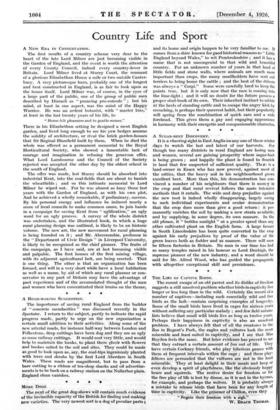Country Life and Sport
A NEW ERA IN CONSERVATION.
The first results of a country scheme very dear to the
heart of the late. Lord Milner are just becoming visible in the Garden of England, and the event is worth the attention of every County Council, indeed every country-lover in Britain. Lord Milner lived at Sturry Court, the remnant of a glorious Elizabethan House a mile or two outside Canter- bury. A very picturesque barn, probably one of the longest and best constructed in England, is as fair to look upon as the house itself. Lord Milner was, of course, in the eyes of a large part of the public, one of the group of public men described by Disraeli as " prancing pro-consuls " ; but his mind, at least in one aspect, was the mind of the Happy
Warrior. He was an ardent botanist, with " master bias," at least in the last twenty years of his life, to " Home-felt pleasures and to gentle scenes."
There in his Elizabethan setting he designed a most English garden, and lived long enough to see his yew hedges assume the solidity of architecture, or rival the brick garden-houses that Sir Reginal Blomfield built by them. When he died the whole was offered as a permanent memorial to the Royal Horticultural Society, who showed a lamentable lack of courage and imagination in refusing the generous offer. What Lord Lambourne and the Council of the Society rejected was accepted the other day by the oldest school in the south of England.
The offer was made, lest Sturry should be absorbed into industrial Kent, into the coal-fields that are about to banish the wheatfields ; and sa this intimate memorial to Lord Milner be wiped out.- For he was almost as busy those last years with the Garden of England, as with his own plot. And he achieved a wholly remarkable, if preliminary, success. By his personal energy and influence he induced nearly a score of local councils to make common cause, to join hands in a campaign for saving Kent from " uglification," an ugly word for an ugly process. A survey of the whole district was undertaken, and the illustrated book, in which a huge
rural planning design was outlined, is likely to be an historic volume. The new art, the new movement for rural planning is being founded on it ; and Mr. Abercrombie, professor in the " Department of Civic Design " in Liverpool University, is likely to be recognized as the chief pioneer. The fruits of the campaign, as I have said, are at last becoming visible and palpable. The first houses of the first mining village, with its adjacent agricultural belt, are being erected. That is one thing. The other is that an organization has been formed, and will in a very short while have a local habitation as well as a name, by aid of which any rural planner or con- servator in any part of Britain may have the advantage of past experience and of the accumulated thought of the men and women who have concentrated their brains on the theme.
* * *






























































 Previous page
Previous page